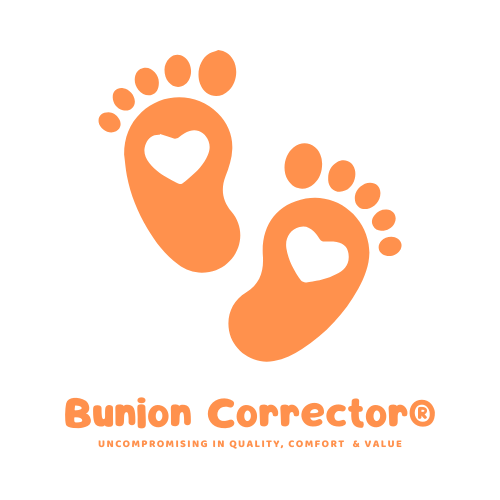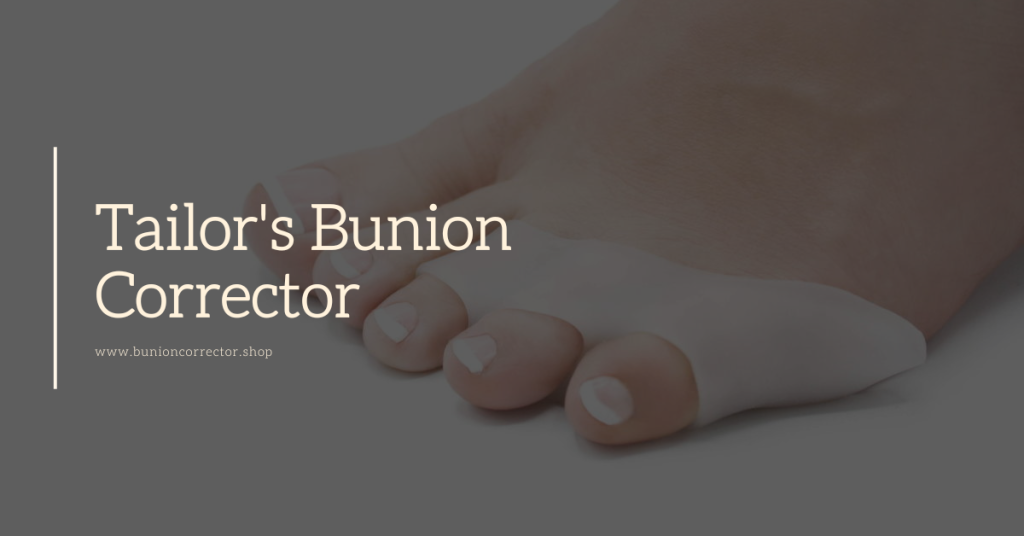If you’ve ever experienced discomfort on the outside of your foot, near your pinky toe, you might be dealing with a Tailor’s Bunion condition. Though less common than regular bunions, this issue can still cause daily pain, irritation, and discomfort. A Tailor’s Bunion Corrector can help alleviate this pain and prevent further problems.
In this blog post, we’ll dive deep into everything you need to know about Tailor’s bunions, including what causes them, how they can be treated, and how using a bunion corrector can make a real difference in your foot health.

What is a Tailor’s Bunion?
Understanding the Basics
A Tailor’s Bunion, also known as a bunionette, is a bony bump that forms outside the foot, right at the base of your pinky toe. Unlike the more common bunion, which affects the big toe, a Tailor’s Bunion is located on the opposite side of the foot.
This condition comes from centuries ago when tailors often sat cross-legged for long periods, putting constant pressure on the outside of their feet. Over time, this pressure led to the formation of bunions in that specific area, and thus, the name Tailor’s Bunion was born.
Causes of Tailor’s Bunion
There are several reasons why someone might develop a Tailor’s Bunion, including:
- Genetics: If bunions run in your family, you might be more prone to developing them.
- Foot structure: Individuals with specific foot shapes, like a narrow heel and a wide forefoot, are more likely to develop a bunionette.
- Poor footwear: Tight, narrow, or poorly fitting shoes can squeeze your toes together and apply pressure on the outside of your foot.
- Repeated stress: Over time, constant pressure or stress on the pinky toe area, such as from prolonged standing, walking, or specific activities like running, can lead to a Tailor’s Bunion.
Symptoms of a Tailor’s Bunion
How to Know If You Have One
The following symptoms can identify a Tailor’s Bunion:
- Pain and swelling: The area around your pinky toe may become sore, especially after wearing tight shoes or being on your feet for long periods.
- Redness or irritation: The bump on the side of your foot may rub against the inside of your shoes, causing redness or irritation.
- Noticeable bump: You’ll often see a visible bump at the base of the pinky toe, which may increase in size over time.
- Difficulty wearing shoes: Narrow shoes, like high heels, may become difficult to wear without pain or discomfort.
What is a Tailor’s Bunion Corrector?
A Simple Solution for Relief
A Tailor’s Bunion Corrector is a simple device designed to help realign the pinky-toe joint, reduce pain, and prevent the condition from worsening. These correctors come in different styles, including soft gel pads, toe separators, and even splints that can be worn at night.
These products work by gently repositioning your pinky toe, reducing the friction and pressure on the bunion. Over time, they can help reduce inflammation, relieve pain, and improve your overall foot alignment.
Types of Tailor’s Bunion Correctors
Different Corrector Options for Different Needs
When it comes to choosing a Tailor’s Bunion Corrector, there are several options available, depending on the severity of your condition and your personal preferences:
- Gel Pads
Gel pads are small, cushioned inserts that can be placed directly over the bunion to reduce pressure from shoes. They help prevent the bunion from rubbing against the inside of your shoes, reducing irritation and pain. These pads are ideal for those who spend long hours on their feet or walking or running.
- Toe Separators
Toe separators are small devices that sit between your pinky toe and the fourth toe. These devices help realign the toes and relieve pressure on the bunion. They are often made from soft, flexible materials like silicone or gel, making them comfortable to wear inside shoes during the day.
- Bunion Splints
A splint is a more rigid corrector designed to be worn while you sleep. It holds your pinky toe correctly, encouraging proper alignment over time. While it might not be the most comfortable option for daytime use, it can effectively provide long-term relief and correction.
- Custom Orthotics
Custom orthotics may be recommended for those with more severe Tailor’s bunions or structural foot issues. These specially-made insoles help support your foot and relieve pressure from the affected area. While more expensive than other options, custom orthotics can provide significant relief for individuals with chronic foot pain.

Benefits of Using a Tailor’s Bunion Corrector
Why You Should Consider Using One
Using a Tailor’s Bunion Corrector can benefit greatly, especially if you catch the condition early. Here are some of the main advantages:
- Pain Relief
By reducing pressure on the bunion and realigning the pinky toe, a bunion corrector can significantly reduce pain and discomfort, making it easier to walk and stand for long periods.
- Preventing Further Damage
If left untreated, a Tailor’s Bunion can become worse over time, leading to more pain and even permanent deformity. A corrector can help prevent the condition from worsening and even reverse some damage.
- Non-Surgical Solution
In many cases, bunion surgery can be avoided using a Tailor’s Bunion Corrector, especially if you start early. This is an excellent alternative for those looking for a non-invasive treatment option.
- Improved Foot Alignment
Over time, a corrector can help improve the alignment of your toes, leading to better overall foot health and comfort. This can also prevent other foot problems, like calluses or hammertoes, from developing.
Tips for Choosing the Right Tailor’s Bunion Corrector
How to Find the Perfect Fit
When shopping for a Tailor’s Bunion Corrector, it’s essential to keep the following tips in mind:
- Comfort: Make sure your corrector is comfortable, mainly if you use it daily.
- Size: Some correctors come in different sizes, so choose one that fits your foot correctly.
- Material: Look for high-quality materials that are soft and flexible, like silicone or gel, to avoid causing additional irritation.
- Consult a specialist: If you need clarification on which corrector is correct, it’s always a good idea to consult a podiatrist or foot specialist.
Final Thoughts
Dealing with a Tailor’s Bunion doesn’t have to be painful or frustrating. The correct Tailor’s Bunion Corrector can relieve discomfort, prevent further damage, and improve your overall foot health. Whether you choose a simple gel pad or opt for a more structured splint, the key is to start early and remain consistent with your treatment.